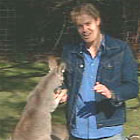Dr Chris Brown looked at the way kangaroos cope with drought.
Aussie battlers
Chris explained that most members of the kangaroo family (Macropodoidea) have an adaptation called Embryonic Diapause. This enables them to recover from drought and make use of ideal conditions as they occur. After mating, an embryo develops until it consists of around 20 cells, then develops no further until the pouch is vacant.
During prolonged drought a female’s milk will dry up, and if the pouch young dies, an embryo is already present in the womb. Shortly after environmental conditions improve, females can give birth. So a female could have three young at varying stages of development: a joey at foot, a pouched young and a dormant embryo in the uterus.
Kangaroos can breed all year round, but most births occur between April and June. A single joey remains in the pouch for about six months and is weaned after about 10 months. The young reach sexual maturity at 14 to 15 months and live for around 8 to 12 years.



